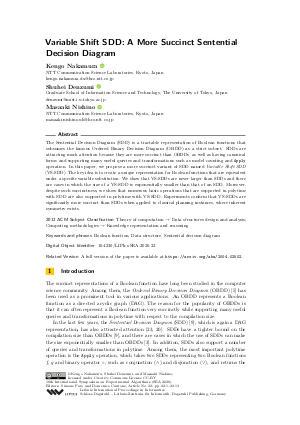Variable Shift SDD: A More Succinct Sentential Decision Diagram
Authors
Kengo Nakamura  ,
Shuhei Denzumi
,
Shuhei Denzumi  ,
Masaaki Nishino
,
Masaaki Nishino 
-
Part of:
Volume:
18th International Symposium on Experimental Algorithms (SEA 2020)
Part of: Series: Leibniz International Proceedings in Informatics (LIPIcs)
Part of: Conference: International Symposium on Experimental Algorithms (SEA) - License:
 Creative Commons Attribution 3.0 Unported license
Creative Commons Attribution 3.0 Unported license
- Publication Date: 2020-06-12
File

PDF
LIPIcs.SEA.2020.22.pdf
- Filesize: 0.64 MB
- 13 pages
Document Identifiers
Related Versions
-
A full version of the paper is available at https://arxiv.org/abs/2004.02502.
Subject Classification
ACM Subject Classification
- Theory of computation → Data structures design and analysis
- Computing methodologies → Knowledge representation and reasoning
Keywords
- Boolean function
- Data structure
- Sentential decision diagram
Metrics
- Access Statistics
-
Total Accesses (updated on a weekly basis)
0PDF Downloads0Metadata Views
Abstract
The Sentential Decision Diagram (SDD) is a tractable representation of Boolean functions that subsumes the famous Ordered Binary Decision Diagram (OBDD) as a strict subset. SDDs are attracting much attention because they are more succinct than OBDDs, as well as having canonical forms and supporting many useful queries and transformations such as model counting and Apply operation. In this paper, we propose a more succinct variant of SDD named Variable Shift SDD (VS-SDD). The key idea is to create a unique representation for Boolean functions that are equivalent under a specific variable substitution. We show that VS-SDDs are never larger than SDDs and there are cases in which the size of a VS-SDD is exponentially smaller than that of an SDD. Moreover, despite such succinctness, we show that numerous basic operations that are supported in polytime with SDD are also supported in polytime with VS-SDD. Experiments confirm that VS-SDDs are significantly more succinct than SDDs when applied to classical planning instances, where inherent symmetry exists.
Cite As Get BibTex
Kengo Nakamura, Shuhei Denzumi, and Masaaki Nishino. Variable Shift SDD: A More Succinct Sentential Decision Diagram. In 18th International Symposium on Experimental Algorithms (SEA 2020). Leibniz International Proceedings in Informatics (LIPIcs), Volume 160, pp. 22:1-22:13, Schloss Dagstuhl – Leibniz-Zentrum für Informatik (2020)
https://doi.org/10.4230/LIPIcs.SEA.2020.22
BibTex
@InProceedings{nakamura_et_al:LIPIcs.SEA.2020.22,
author = {Nakamura, Kengo and Denzumi, Shuhei and Nishino, Masaaki},
title = {{Variable Shift SDD: A More Succinct Sentential Decision Diagram}},
booktitle = {18th International Symposium on Experimental Algorithms (SEA 2020)},
pages = {22:1--22:13},
series = {Leibniz International Proceedings in Informatics (LIPIcs)},
ISBN = {978-3-95977-148-1},
ISSN = {1868-8969},
year = {2020},
volume = {160},
editor = {Faro, Simone and Cantone, Domenico},
publisher = {Schloss Dagstuhl -- Leibniz-Zentrum f{\"u}r Informatik},
address = {Dagstuhl, Germany},
URL = {https://drops.dagstuhl.de/entities/document/10.4230/LIPIcs.SEA.2020.22},
URN = {urn:nbn:de:0030-drops-120968},
doi = {10.4230/LIPIcs.SEA.2020.22},
annote = {Keywords: Boolean function, Data structure, Sentential decision diagram}
}
Author Details
- Graduate School of Information Science and Technology, The University of Tokyo, Japan
References
- Anuchit Anuchitanukul, Zohar Manna, and Tomás E. Uribe. Differential BDDs. In Computer Science Today, pages 218-233, 1995. URL: https://doi.org/10.1007/BFb0015246.
- Anicet Bart, Frédéric Koriche, Jean-Marie Lagniez, and Pierre Marquis. Symmetry-driven decision diagrams for knowledge compilation. In ECAI, pages 51-56, 2014. URL: https://doi.org/10.3233/978-1-61499-419-0-51.
-
Simone Bova. SDDs are exponentially more succinct than OBDDs. In AAAI, pages 929-935, 2016.

-
Guy Van den Broeck and Adnan Darwiche. On the role of canonicity in knowledge compilation. In AAAI, pages 1641-1648, 2015.

- Randal E. Bryant. Graph-based algorithms for boolean function manipulation. IEEE Trans. Comput., C-35:677-691, 1986. URL: https://doi.org/10.1109/TC.1986.1676819.
- Randal E. Bryant. Chain reduction for binary and zero-suppressed decision diagrams. In TACAS, pages 81-98, 2018. URL: https://doi.org/10.1007/978-3-319-89960-2_5.
-
Arthur Choi and Adnan Darwiche. Dynamic minimization of sentential decision diagrams. In AAAI, pages 187-194, 2013.

- Arthur Choi and Adnan Darwiche. The SDD package: version 2.0. http://reasoning.cs.ucla.edu/sdd/, 2018. URL: http://reasoning.cs.ucla.edu/sdd/.
- Adnan Darwiche. SDD: a new canonical representation of propositional knowledge bases. In IJCAI, pages 819-826, 2011. URL: https://doi.org/10.5591/978-1-57735-516-8/IJCAI11-143.
- Adnan Darwiche and Pierre Marquis. A knowledge compilation map. J. Artif. Intell. Res., 17:229-264, 2002. URL: https://doi.org/10.1613/jair.989.
-
Héiène Fragier and Pierre Marquis. On the use of partially ordered decision graphs for knowledge compilation and quantified Boolean formulae. In AAAI, pages 42-47, 2006.

- Jordan Gergov and Christoph Meinel. Efficient Boolean manipulation with OBDD’s can be extended to FBDD’s. IEEE Trans. Comput., 43:1197-1209, 1994. URL: https://doi.org/10.1109/12.324545.
-
Hiroaki Iwashita, Yoshio Nakazawa, Jun Kawahara, Takeaki Uno, and Shin-ichi Minato. Efficient computation of the number of paths in a grid graph with minimal perfect hash functions. Technical Report TCS-TR-A-13-64, Division of Computer Science, Hokkaido University, 2013.

-
Donald E. Knuth. The Art of Computer Programming, volume 4A: Combinatorial Algorithms, Part I. Addison-Wesley, 2011.

-
Neal Madras and Gordon Slade. The Self-Avoiding Walk. Birkhäuser Basel, 2011.

- Jean-Christophe Madre and Jean-Paul Billon. Proving circuit correctness using formal comparison between expected and extracted behaviour. In DAC, pages 205-210, 1988. URL: https://doi.org/10.1109/DAC.1988.14759.
- Shin-ichi Minato. Zero-suppressed BDDs for set manipulation in combinatorial problems. In DAC, pages 272-277, 1993. URL: https://doi.org/10.1145/157485.164890.
- Shin-ichi Minato, Nagisa Ishiura, and Shuzo Yajima. Shared binary decision diagram with attributed edges for efficient boolean function manipulation. In DAC, pages 52-57, 1990. URL: https://doi.org/10.1145/123186.123225.
-
Masaaki Nishino, Norihito Yasuda, Shin-ichi Minato, and Masaaki Nagata. Compiling graph substructures into sentential decision diagrams. In AAAI, pages 1213-1221, 2017.

-
Umut Oztok and Adnan Darwiche. A top-down compiler for sentential decision diagrams. In IJCAI, pages 3141-3148, 2015.

-
Héctor Palacios, Blai Bonet, Adnan Darwiche, and Héctor Geffner. Pruning conformant plans by counting models on compiled d-DNNF representations. In ICAPS, pages 141-150, 2005.

-
Tian Sang, Paul Beame, and Henry Kautz. Performing Bayesian inference by weighted model counting. In AAAI, pages 475-481, 2005.

-
Jonas Vlasselaer, Joris Renkens, Guy Van den Broeck, and Luc De Raedt. Compiling probabilistic logic programs into sentential decision diagrams. In PLP, 2014.

